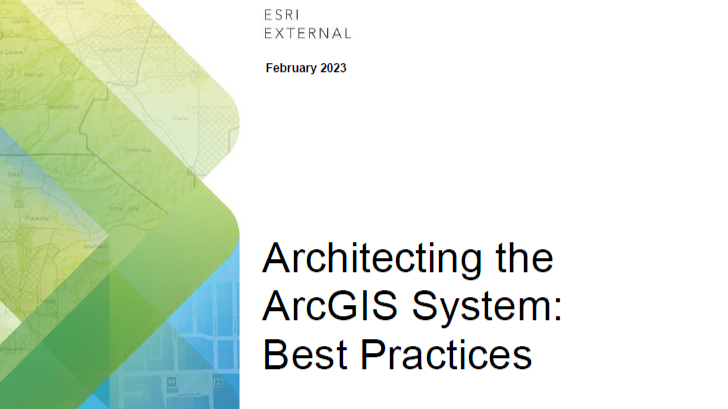1. Introduction
Designing an effective ArcGIS Enterprise deployment requires careful architectural planning to meet the needs of diverse organizational requirements. A successful deployment is not solely dependent on hardware or software installation, but rather on aligning system capabilities with anticipated user behaviors, the number and roles of users, and the desired performance level based on service-level agreements (SLAs). The process involves anticipating how ArcGIS Enterprise will be utilized, the intensity of spatial data processing, collaboration needs, and future expansion possibilities.
2. Purpose and Scope of Best Practices
The Architecting the ArcGIS System Best Practices document outlines key considerations, best practices, and recommended strategies for planning and deploying ArcGIS Enterprise systems. It provides clarity on common misconceptions, promotes an understanding of scalable and maintainable system design, and guides GIS professionals in optimizing performance and reliability. This resource is essential for system administrators, IT architects, and GIS strategists involved in deploying and managing enterprise-level GIS solutions.
3. Core Components of the ArcGIS Enterprise Base Deployment
At the heart of every ArcGIS Enterprise deployment is the base deployment, which is a foundational set of components that support core GIS capabilities. These components include:
- Portal for ArcGIS, which provides the primary user interface for managing, organizing, and sharing geospatial content across the enterprise;
- ArcGIS Server, licensed as a GIS Server, responsible for delivering map services, geoprocessing services, and other server-side functionality;
- ArcGIS Data Store, a managed storage solution that hosts feature layers, tile caches, and analytical outputs;
- ArcGIS Web Adaptor, which acts as a reverse proxy, routing web traffic to internal services and enabling integration with enterprise security models.
Together, these components support functionalities such as data visualization, spatial analysis, map publishing, content sharing, collaboration across users, and integration with authoritative content in the ArcGIS Living Atlas.
4. Deployment Patterns: Single vs. Multi-Tier Architectures
ArcGIS Enterprise can be deployed using either a single-machine or a multi-tier architecture depending on the scale and complexity of the organization’s needs. In a Single-Machine Deployment (also known as “All-in-One”), all core components are installed on a single server. This pattern is typically used for small-scale or pilot implementations due to its simplicity and lower resource requirements.
Conversely, Multi-Tier Deployments distribute components across multiple servers to optimize load balancing, performance, and scalability. This model is ideal for large enterprises, high-availability environments, or systems expecting heavy data processing and concurrent user loads. Separating the web tier, portal tier, server tier, and data storage tiers enhances performance tuning, fault isolation, and system manageability.
5. Scaling the Base Deployment
Scaling strategies are essential to maintain consistent performance as system demand increases. For Portal for ArcGIS, scaling usually involves increasing hardware resources such as CPU and RAM. The Hosting Server can be scaled either vertically by enhancing machine resources or horizontally by adding additional machines to the server site. For large workloads, workload separation (e.g., separating analysis from hosting services) is encouraged to avoid resource contention.
For the ArcGIS Data Store, vertical scaling through resource upgrades is the primary method. Administrators must monitor resource usage—particularly CPU, memory, disk space, and input/output operations—to identify and eliminate bottlenecks. Understanding performance thresholds and implementing proactive monitoring are critical for ensuring a stable deployment.
6. Expanding Beyond the Base Deployment
Organizations can expand the capabilities of ArcGIS Enterprise by integrating additional server roles to address specific analytical or operational needs. These include:
- GIS Server Sites: Used for workload separation and high-demand services like rendering dynamic maps or executing heavy geoprocessing tasks.
- Image Server: Supports hosting and processing of raster imagery. It enables image hosting, dynamic image services, and raster analytics—each of which can be deployed as dedicated server sites.
- GeoAnalytics Server: Offers scalable big data analytics for processing large volumes of vector and tabular data. It requires integration with the spatiotemporal big data store for output storage.
- GeoEvent Server: Facilitates real-time data ingestion, filtering, analysis, and alerting from sensor networks. For high-throughput scenarios, multiple single-machine GeoEvent sites may be deployed.
- Notebook Server: Hosts Jupyter-style notebooks integrated with ArcGIS, allowing users to blend GIS workflows with data science capabilities. It uses Docker containers to isolate workloads and support parallel execution.
7. Advanced Deployment Patterns and System Resilience
Beyond component expansion, several advanced deployment strategies ensure system flexibility, collaboration, and resilience. The High Availability (HA) approach involves deploying redundant components within a single data center or cloud zone to minimize downtime during maintenance or failure. Disaster Recovery (DR) setups replicate the system across different geographic locations to maintain continuity in the event of a site-wide outage.
In addition, Distributed Collaboration is a powerful feature that enables content sharing between multiple ArcGIS Enterprise deployments and ArcGIS Online. This facilitates cross-organization collaboration, content synchronization, and federated workflows in distributed environments.
8. Automation Tools for Streamlined Deployment
Automation is central to efficient, consistent, and reproducible ArcGIS Enterprise deployments. Several tools and frameworks support automation at different levels:
- ArcGIS Enterprise Builder: Simplifies installation and configuration of the base deployment on a single machine.
- Cloud Deployment Tools: Many cloud providers offer preconfigured machine images, templates, or automation scripts tailored for ArcGIS environments.
- Chef: An open-source configuration management tool for scripting automated deployments of complex, multi-tier systems.
- Windows PowerShell Desired State Configuration (DSC): Allows infrastructure to be defined and enforced as code, making it easier to manage large deployments with minimal manual intervention.
9. Conclusion and Key Recommendations
Architecting the ArcGIS System involves thoughtful planning that aligns system architecture with organizational goals, usage scenarios, and growth expectations. It is important to stay informed about current best practices and technology updates provided by Esri. Organizations are encouraged to leverage the federated server model to extend system functionality, and to adopt automation tools for reducing complexity and ensuring consistency in deployments.
Ultimately, the goal is to design an ArcGIS Enterprise architecture that is not only functional and performant but also resilient, secure, and scalable to meet both present and future GIS demands.
Nicolas Ni, January 12, 2025


